Please report any broken links or trouble you might come across to the Webmaster.
Please take a moment to let us know so that we can correct any problems and make your visit as enjoyable and as informative as possible.
| Click On Image For Full Size | Size | Image Description | Source | |
|---|---|---|---|---|
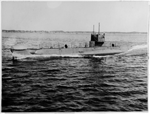 0805106 | 1.30k | L-11 (SS-51) running trials off Provincetown, Massachusetts, circa 1916. | Photo NH 51173 courtesy of history.navy.mil | |
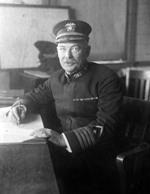 0805107 | 194k | L-11's (SS-51) Sponsor was Miss Mary Richards Latimer,(No photo) daughter of Commander J. L. Latimer, U. S. Navy. A 25 February 1919 photograph taken at the Pelham Bay, New York, Naval Training Station. He was serving as Commandant there at the time. Captain Latimer, a former Commanding Officer of the battleship Rhode Island (BB-17), succeeded Commander W.F. Franklin as Commandant at Pelham. He later was promoted to Judge Advocate General. | Photo NH-48221 courtesy of history.navy.mil | |
 |
743k | All the news that's fit to misprint, #1. UNITED STATES TESTS FIRST OF BIG NEW SEA-GOING SUBMARINES The M-1 (SS-47) is shown on her trial trip off Provincetown, Mass., on 6 July. She is 230 1/2 feet long, with 21 1/2-foot beam. Her radius of action is 2,000 miles. She is not as large as the German submarine Deutschland, now at Baltimore, whose length is 315 feet, with a 30 foot beam. It is actually an EB design L-class boat. The paper that originally published the photo misidentified it. The caption is wrong. | Photo & text i.d. courtesy of David Johnston Image provided by: Penn State University Libraries; University Park, PA. Photo from Evening Public Ledger. (Philadelphia [Pa.]) 1914-1942, 11 July 1916, Night Extra, Image 2, via chroniclingamerica.loc.gov. | |
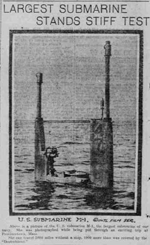 |
531k | All the news that's fit to misprint, # 2. LARGEST SUBMARINE STANDS STIFF TEST Above is a picture of the U.S. submarine M-1 (SS-47) the largest submarine of our navy. She was photographed while being put through an exciting trip at Provincetown. Mass. She can travel 5000 miles without a stop, 1000 more than was covered by the Deutschland.". It is actually an EB design L-class boat. The paper that originally published the photo misidentified it. The caption is wrong. | Photo & text i.d. courtesy of David Johnston Image and text provided by University of North Texas; Denton, TX. Photo from El Paso Herald. (El Paso, Tex.) 1901-1931, 21 July 1916, HOME EDITION, Image 6, via chroniclingamerica.loc.gov. | |
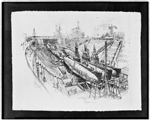 |
127k | What looks to be L-class (SS-40/51) submarines in dry dock, by the artist Joseph Pennell, 1917. | Photo # 3c19552v, LC-USZ62-119552. Photograph courtesy of memory.loc.gov. | |
 |
49k | E.B.'s L-11 (SS-51), was a unit of the repeat L-class (SS-40 / 51). The circular plate on the hull forward covers a Fessenden oscillator for underwater signaling. The 3in-/23 gun forward is shown in stowed position. | Drawing by Jim Christley. Text courtesy of U.S. Submarines Through 1945, An Illustrated Design History by Norman Friedman. Naval Institute Press. |
|
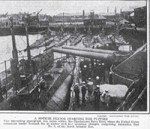 |
496k | A MOTHER SEADOG GUARDING HER PUPPIES This interesting photograph was taken within the Charlestown Navy Yard, where the United States submarine tender Tonopah (M-8) lies at anchor with her undersea charges, comprising submarine fleet No.3, of the North Atlantic fleet. Probable submarines are the E.B. designed L-boats (SS-40 / 43 & 49 / 51), [L-1 thru 4 & 9 thru 11.] | Image and text provided by Penn State University Libraries; University Park, PA. Photo from Evening Public Ledger.(Philadelphia [Pa.]) 1914-1942, 02 June 1917, Postscript Edition, Pictorial Section, Image 19, via chroniclingamerica.loc.gov. |
|
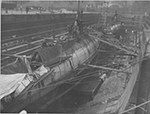 | 403k | US Submarines in Dry Dock at Charlestown Navy Yard. The L-11 (SS-51) & L-9 (SS-49). | Photographer: Kadel & Herbert, NY. National Archives Identifier: 45548689 Local Identifier: 165-WW-505C-1. Photo courtesy of catalog.archives.gov | |
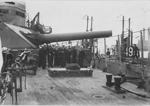 |
1.28k | The photo above shows the same scene here but from a different angle. View on the Tonopah's (M-8) foredeck, showing 12" guns and crewmen, taken while she was serving as submarine tender at the Boston Navy Yard, Charlestown, Massachusetts, circa June 1917. Submarines alongside are L-11 (SS-51) and L-9 (SS-49). Note the workbench, with vise attached, in the left foreground. |
Photo i.d. via Ric Hedman. National Archives Identifier: 45513433 Local Identifier: 165-WW-337D-63 Photo courtesy of catalog.archives.gov |
|
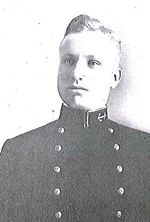 0805108 | 1.30k | Lt. Comdr. Andrew C. Bennett in June, 1917, assumed command of the L-11 (SS-51), based at Bantry Bay, Ireland. He was awarded the Navy Cross for services in that command. The citation follows: “For distinguished service in the line of his profession in command of the USS AL-11. While enroute from Newport to the Azores his submarine was separated from the escort and other submarines of the squadron, leaving him without a rendezvous. He thereupon proceeded to his destination successfully, assuming the great responsibility of starting a 1700 mile Atlantic Ocean run in winter weather in a submarine of a class that had never been considered reliable for service of this character.” | Partial text & photo courtesy of history.navy.mil | |
 |
100k | Circa December 1917 - January 1918 photo of the L-9 (SS-49), L-10 (SS-50) & L-11 (SS-51) wearing the A.L. of WW I, at Portsmouth, New Hampshire. | USN photo courtesy of Robert M. Cieri. | |
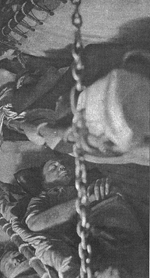 |
753k | Sack Time. Typical of the subject submarines, here men are stacked four high on canvas fold away bunks aboard an American L-boat in the European theater. | Photo from Illustrated London News, 28 September, 1918, courtesy of Beneath the Surface: World War I Submarines Built in Seattle and Vancouver by Bill Lightfoot. | |
 |
490k | L-11 (SS-51), starboard bow view during WWI in Scotland. | National Archives Identifier: 45513723 Local Identifier: 165-WW-338B-016 Photo courtesy of catalog.archives.gov | |
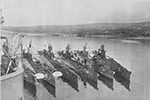 | 1.02k | L-boats alongside Bushnell (AS-2) at Bantry Bay, Ireland, in 1918.
These submarines are, from left to right: L-11 (SS-51), L-10 (SS-50), L-1 (SS-40), L-9 (SS-49) & L-2 (SS-41). Identification marks painted on these "boats"' fairwaters include the letter "A", to distinguish them from British L-boats . | National Archives Identifier: 45513695 Local Identifier: 165-WW-338B-003 Photo courtesy of catalog.archives.gov | |
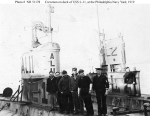 | 77k | L-11 (SS-51) with crew members on deck, at the Philadelphia Navy Yard, circa February 1919. L-2 (SS-41), is in the immediate background. | USNHC photograph, # NH 51178. | |
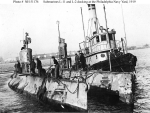 | 116k | L-11 (SS-51) at left, and L-2 (SS-41), docking at the Philadelphia Navy Yard, Pennsylvania, assisted by a harbor tug, circa February 1919. | USNHC photograph, # NH 51176. | |
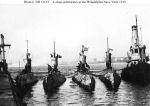 | 89k | L-class class submarines tied up at the Philadelphia Navy Yard, Pennsylvania, with a harbor tug outboard, circa February 1919.
Submarines are (from left to right): L-3 (SS-42); L-9 (SS-49); L-11 (SS-51); and L-2 (SS-41). | USNHC photograph, # NH 51167. | |
 |
100k | L-3 (SS-42) - left; L-9 (SS-49) - center; and L-11 (SS-51) - right, at the Philadelphia Navy Yard, Pennsylvania, circa February 1919. "Homeward-bound" pennant flying from L-9's periscope indicates that this photo may have been taken as the submarines arrived home following World War I service in British waters. | US Naval Historical Center photo # NH 51168. | |
 |
59k | L-11 (SS-51), at left, and L-4 (SS-43) at the U.S. Naval Academy, Annapolis, Maryland, circa 1919. Note these submarines' 3"/23 deck guns, located just forward of their fairwaters. L-11's is retracted, while that of L-4 is in operating position. | USN photo # NH 103253, from the collections of the US Naval Historical Center. Collection of Rear Admiral Harold F. Pullen, USN. Loaned via Captain Paul B. Ryan, USN (Retired), 1977. | |
 |
529k | Stern view of the L-11 (SS-51) in dry dock probably after WW I. | USN photo courtesy of Scott Koen & ussnewyork.com | |
 |
583k | AMERICAN SUBMARINES return to the base to "feed." A School of U.S. subs alongside their mother ship at an advance base on the Irish coast. L-9 (SS-49) is the second submarine on the right, what might be L-11 (SS-51) is the second submarine on the left. | Image and text provided by Penn State University Libraries; University Park, PA. Photo & text by Evening Public Ledger. (Philadelphia [Pa.]) 1914-1942, 23 January 1919, Night Extra Closing Stock Prices, Image 20, courtesy of chroniclingamerica.loc.gov. |
|
 |
873k | AMERICAN U-BOATS BACK FROM THE WAR After 15 months hunting of German U-boats in the Irish Sea, the flotilla of submarines shown above returned to the League Island navy yard at Philadelphia. The L-11 (SS-51), (third from left) had many desperate encounters with the enemy boats, including a fight below the surface with a Hun sub, which L-11 subsequently vanquished. L-9 (SS-49) is the second boat to the left, along with two unidentified submarines, which I believe are L-2 (SS-41) at the far right & L-3 (SS-42) on the left. |
National Archives Identifier: 45513697 Local Identifier: 165-WW-338B-3A Photo courtesy of catalog.archives.gov Image and text provided by University of Oregon Libraries; Eugene, OR. Photo courtesy of The Evening Herald. The Evening Herald. (Klamath Falls, Or.) 1906-1942, 24 April 1919, Image 3, via chroniclingamerica.loc.gov. | |
 0807700 | 674k | Philadelphia in the late 1920’s. From left to right: Two K-class: (No definite i.d. which ones of the following 8 ): K-1 (SS-32), K-2 (SS-33), K-3 (SS-34), K-4 (SS-35), K-5 (SS-36), K-6 (SS-37), K-7 (SS-38), K-8 (SS-39). Four EB design L-class (No definite i.d. which ones of the following 4 ): L-2 (SS-41), L-3 (SS-42), L-9 (SS-49) & L-11 (SS-51). Two Lake design O-class (No definite i.d. which ones of the first 4): O-11 (SS-72), O-13 (SS-74), O-14 (SS-75), O-15 (SS-76 ), with the last boat being O-16 (SS-77) on far right. All boats are in various states of disrepair, and all would be disposed of by scrapping by the summer of 1930 in accordance with the London Naval Treaty. | Photo courtesy of David Wright. Text i.d. via David Johnston. |
|
| Back To The Main Photo Index | Back To the Submarine Index |
|
Problems and site related matters, E-mail Webmaster |
|
This page is created and maintained by Michael Mohl All Pages © 1996 - 2025 NavSource History |